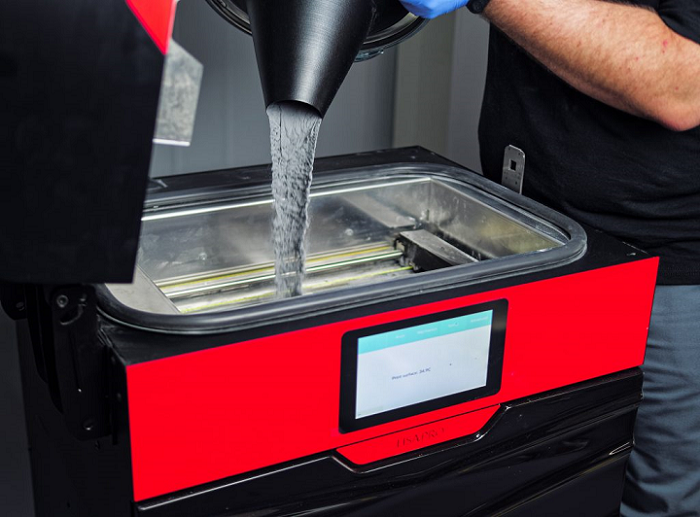Desktop selective laser sintering (SLS) 3D printing firm Sinterit, manufacturer of the Lisa series, knows that there are plenty of people out there who think that SLS is a costly technology. But the company says that, due to the “quality and precision” that its machines offer, this should no longer be an issue. Stating in a press release that “what drives cost-efficiency of SLS 3D printing” is “refresh and pack,” the Poland-based company announced that its PA12 powder has achieved the lowest refresh ratio yet at 26%…possibly setting a new standard to which other SLS 3D printing companies can aspire.
“Our way is to make 3D printing technology more accessible,” said Maxime Polesello, CEO of Sinterit. “Lowering the cost of prints is just the next step. Not the last.”
A little background first: SLS technology uses an infrared laser, in high temperatures, to consolidate the powder grains before they’re bound with the beam. Then, a roller spreads a thin layer of powder across the print bed, and the material is sintered (using heat or pressure to form a solid mass of material with liquefying it) into the shape specified by a 3D model file.
According to 3DPrint.com’s own Joris Peels, the Vice President of Consulting at SmarTech Analysis, SLS technology is likely “the most high volume, high throughput 3D printing technology for high volume manufacturing of relatively small polymer parts in the medical field.” It can create parts with excellent levels of detail and mechanical qualities, though it might take a long time, and due to its predictability and high volume process, SLS is also fairly cost-effective as well, going back to Sinterit’s point.
Obviously, being an SLS company, Sinterit is very focused on the powder aspect of this technology. In 2017, it introduced a powder sieve to complement the Lisa 3D printer, and just a couple of months ago, the company released three accessories useful in managing SLS prints, including a powder vacuum for removing unsintered powder from print chambers. Only the powder that prints the object is used in the SLS process, while the rest is used as a natural support. Unsintered powder can be reused after adding fresh powder to the mix.
 The powder refreshing ratio is important because of the costs of SLS – the amount of additional refreshing powder that’s necessary is what actually sets the final 3D printing cost. This means that the lower the ratio of powder refreshing, the lower your ROI will be, and the fact that Sinterit has achieved a 26% ratio is good news for its customers.
The powder refreshing ratio is important because of the costs of SLS – the amount of additional refreshing powder that’s necessary is what actually sets the final 3D printing cost. This means that the lower the ratio of powder refreshing, the lower your ROI will be, and the fact that Sinterit has achieved a 26% ratio is good news for its customers.
“The total cost of using the machine is the purchase of equipment, service, and material. We’ve just improved this third parameter, by lowering the amount of powder in the refreshing cycle,” stated Sinterit’s Co-Founder Konrad Głowacki, who’s responsible for the company’s powder development. “We’ve already revolutionized the cost of the system and service, now it’s time for reducing the cost of printing.”
On a related note, SLS 3D printing allows users to print many models, even up to 1,000, in a single job. Cost efficiency is obviously important in this aspect, and the lower powder refresh ratio that Sinterit can now offer means that the print cost goes down.
Sinterit continues to make waves in the SLS market, increasing its R&D activities, bringing its products to the US, introducing new product accessories, and it recently released a software update that can adapt its 3D printers to fit the requirements of Industry 4.0. Now with this news of a low powder refresh ratio for its PA12, it seems like Sinterit isn’t slowing down anytime soon.
(Images courtesy of Sinterit)
Subscribe to Our Email Newsletter
Stay up-to-date on all the latest news from the 3D printing industry and receive information and offers from third party vendors.
You May Also Like
Profiling a Construction 3D Printing Pioneer: US Army Corps of Engineers’ Megan Kreiger
The world of construction 3D printing is still so new that the true experts can probably be counted on two hands. Among them is Megan Kreiger, Portfolio Manager of Additive...
US Army Corps of Engineers Taps Lincoln Electric & Eaton for Largest 3D Printed US Civil Works Part
The Soo Locks sit on the US-Canadian border, enabling maritime travel between Lake Superior and Lake Huron, from which ships can reach the rest of the Great Lakes. Crafts carrying...
Construction 3D Printing CEO Reflects on Being Female in Construction
Natalie Wadley, CEO of ChangeMaker3D, could hear the words of her daughter sitting next to her resounding in her head. “Mum, MUM, you’ve won!” Wadley had just won the prestigious...
1Print to Commercialize 3D Printed Coastal Resilience Solutions
1Print, a company that specializes in deploying additive construction (AC) for infrastructure projects, has entered an agreement with the University of Miami (UM) to accelerate commercialization of the SEAHIVE shoreline...
































